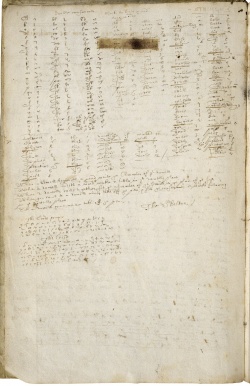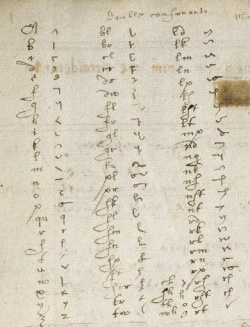Oxinden cipher: Difference between revisions
JessicaOtis (talk | contribs) (Created page with "{{Draft}} The Oxinden cipher is an early modern [https://en.wikipedia.org/wiki/Substitution_cipher substitution cipher] used by the letter-writer and poet, Henry Oxinden of B...") |
No edit summary |
||
| (9 intermediate revisions by 2 users not shown) | |||
| Line 1: | Line 1: | ||
The Oxinden cipher is an early modern [https://en.wikipedia.org/wiki/Substitution_cipher substitution cipher] used by the letter-writer and poet, Henry Oxinden of Barham (1609-1670) and his second wife Katherine Oxinden nee Culling (1624 - 1698). Instances of the cipher can be found in letters held by the British Library and almanacs held by the Huntington Library. | The Oxinden cipher is an early modern [https://en.wikipedia.org/wiki/Substitution_cipher substitution cipher] used by the letter-writer and poet, Henry Oxinden of Barham (1609-1670) and his second wife Katherine Oxinden nee Culling (1624 - 1698). Instances of the cipher can be found in letters held by the British Library and almanacs held by the Huntington Library. | ||
[[file:064426.jpg|thumb|right|250px|Oxinden Cipher, v.b.110 1<sup>v</sup>.]] | |||
The Oxinden cipher consists of twenty-five symbol substitutes for twenty-four letters found in the modern English alphabet – treating ''i'' and ''j'' as a single letter, and ''u'' and ''v'' as a single letter – along with a symbol for the digraph ''th''. Neither Henry nor Katherine appear to use the letter thorn – þ – for ''th ''in their other writings, however it seems likely their use of a separate symbol for ''th'' reflects the legacy of the thorn in older versions of the English alphabet. | |||
The substitute symbols include a mixture of Latin letters, Greek letters, and Hindu-Arabic numerals, along with what appear to be astrological and shorthand symbols. The latter is especially interesting as a copy of Thomas Shelton's shorthand appears at the front of the [[Miscellany of Henry Oxinden, ca. 1642-1670 V.b.110|Oxinden miscellany]], held by the Folger Shakespeare Library. Of particular interest are the shorthand symbols for ''d, k'', and ''l''. The shorthand symbol for ''d'' appears identical to the symbol the Oxindens use for the letter ''a'', while shorthand symbols for'' k'' and'' l ''appear to be identical to the cipher's symbols for those same letters. For a closer look, see the [https://digitalcollections.folger.edu/img64426 full page in our digital image collection]. | |||
The substitute symbols include a mixture of Latin letters, Greek letters, and Hindu-Arabic numerals, along with what appear to be astrological and shorthand symbols. The latter is especially interesting as a copy of Thomas Shelton's shorthand appears at the front of the [[ | |||
[[file:Detail cipher.jpg|thumb|right|250px|Oxinden Cipher, v.b.110 1<sup>v</sup>, detail showing brevigraphs.]] | |||
Henry's invention of the cipher dates to no later than January of 1641, when he encoded information in his annual almanac. It appears to have remained generally consistent over the following decades, suggesting it was already fully formed at this time. | Henry's invention of the cipher dates to no later than January of 1641, when he encoded information in his annual almanac. It appears to have remained generally consistent over the following decades, suggesting it was already fully formed at this time. | ||
Although he married Katherine in 1642, his use of the cipher to encode information about love letters sent to another woman in 1646 suggests that he did not initially share the cipher with his wife. The first known evidence of Katherine using the cipher only dates to letters sent in February of 1663. Her version of the cipher is largely consistent with Henry's, however there are two primary differences: while her husband tended to use the letter y as the symbol for g, Katherine instead generally used the letter y to mean y, and a modified y-like symbol for g. Katherine also often used the numeral 2 – Henry's symbol for the letter t – as a shorthand for the word "to". She continued to employ the cipher even after Henry's death. | Although he married Katherine in 1642, his use of the cipher to encode information about love letters sent to another woman in 1646 suggests that he did not initially share the cipher with his wife. The first known evidence of Katherine using the cipher only dates to letters sent in February of 1663. Her version of the cipher is largely consistent with Henry's, however there are two primary differences: while her husband tended to use the letter ''y'' as the symbol for'' g'', Katherine instead generally used the letter ''y'' to mean'' y'', and a modified y-like symbol for ''g''. Katherine also often used the numeral 2 – Henry's symbol for the letter ''t ''– as a shorthand for the word "to". She continued to employ the cipher even after Henry's death. | ||
[[Category:Collection ]] | |||
[[Category:Manuscripts ]] | |||
[[Category:17th century]] | |||
Latest revision as of 15:24, 17 July 2024
The Oxinden cipher is an early modern substitution cipher used by the letter-writer and poet, Henry Oxinden of Barham (1609-1670) and his second wife Katherine Oxinden nee Culling (1624 - 1698). Instances of the cipher can be found in letters held by the British Library and almanacs held by the Huntington Library.
The Oxinden cipher consists of twenty-five symbol substitutes for twenty-four letters found in the modern English alphabet – treating i and j as a single letter, and u and v as a single letter – along with a symbol for the digraph th. Neither Henry nor Katherine appear to use the letter thorn – þ – for th in their other writings, however it seems likely their use of a separate symbol for th reflects the legacy of the thorn in older versions of the English alphabet.
The substitute symbols include a mixture of Latin letters, Greek letters, and Hindu-Arabic numerals, along with what appear to be astrological and shorthand symbols. The latter is especially interesting as a copy of Thomas Shelton's shorthand appears at the front of the Oxinden miscellany, held by the Folger Shakespeare Library. Of particular interest are the shorthand symbols for d, k, and l. The shorthand symbol for d appears identical to the symbol the Oxindens use for the letter a, while shorthand symbols for k and l appear to be identical to the cipher's symbols for those same letters. For a closer look, see the full page in our digital image collection.
Henry's invention of the cipher dates to no later than January of 1641, when he encoded information in his annual almanac. It appears to have remained generally consistent over the following decades, suggesting it was already fully formed at this time.
Although he married Katherine in 1642, his use of the cipher to encode information about love letters sent to another woman in 1646 suggests that he did not initially share the cipher with his wife. The first known evidence of Katherine using the cipher only dates to letters sent in February of 1663. Her version of the cipher is largely consistent with Henry's, however there are two primary differences: while her husband tended to use the letter y as the symbol for g, Katherine instead generally used the letter y to mean y, and a modified y-like symbol for g. Katherine also often used the numeral 2 – Henry's symbol for the letter t – as a shorthand for the word "to". She continued to employ the cipher even after Henry's death.

